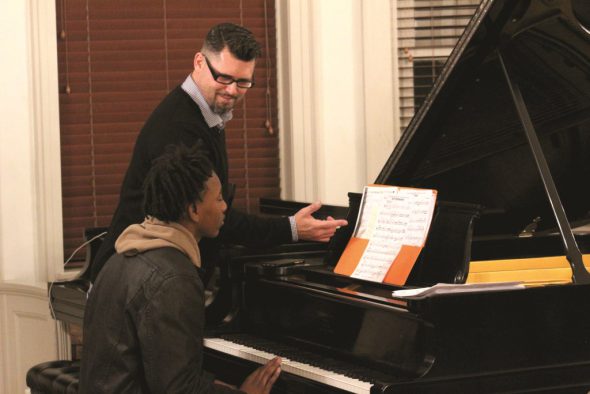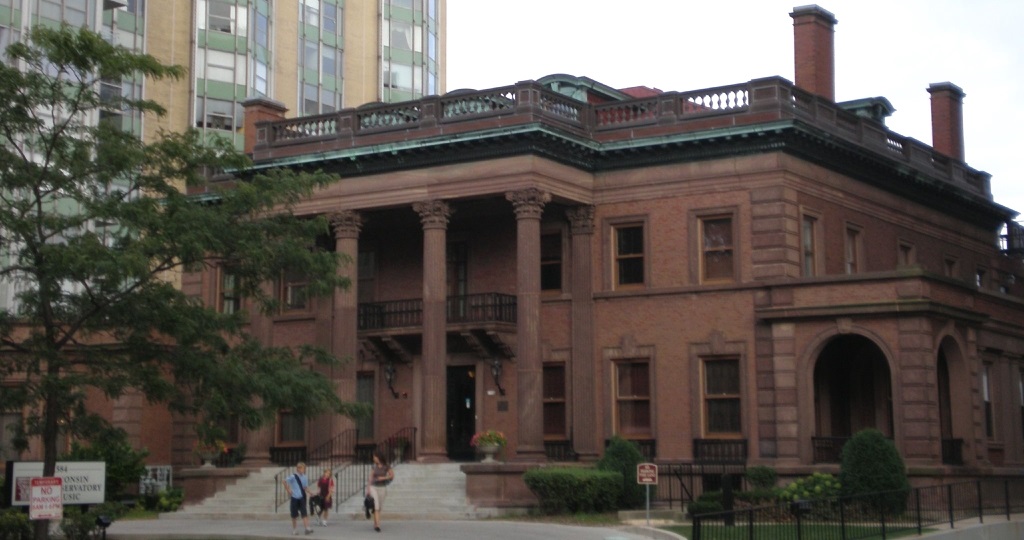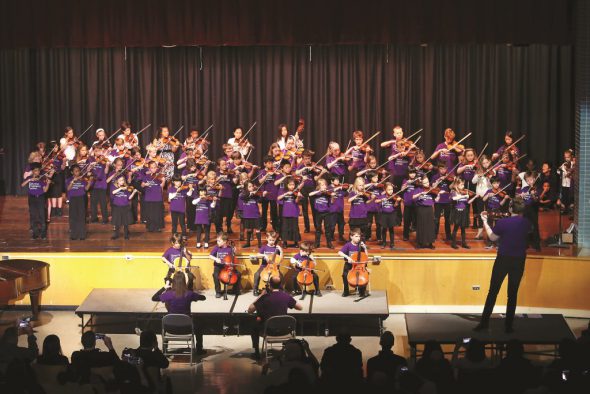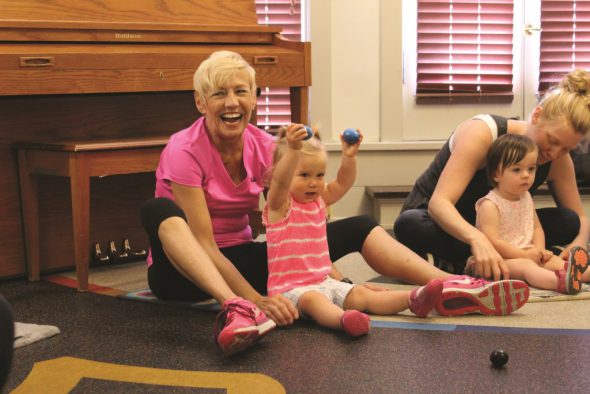Not Your Grandpa’s Conservatory
The Wisconsin Conservatory of Music is rebranding itself. All it needs is the right theme song.
You might say the Wisconsin Conservatory of Music is writing a new score for itself. The new composition is both simple and complex, involving internal changes to keep the conservatory humming combined with external rebranding to help the community better understand how the conservatory has changed.
For a prestigious and storied school, that can be a lot more difficult than it sounds.
You know the building, even if you were never quite sure what went on in there. It’s a highly visible mansion the size of a dirigible on Prospect Avenue just south of Brady Street. The Conservatory has called the classic McIntosh-Goodrich Mansion, built in 1903, its home for more than 80 years. The historic building contains both the beautiful Helen Bader Recital Hall and the Dorthea Library.
But the school had been around for decades before moving to this building.
“The conservatory has been in existence for 118 years,” says Adam Shafer, director of development & Marketing for the Conservatory. “We’ve embarked on a rebranding effort we’re looking to begin in the middle of next year into fiscal 2019.”
The Conservatory is among the nation’s oldest community-based arts schools. It was founded way back in 1899 by William Boeppler, Hugo Kaun, and Dr. Louis Frank, to provide music education, both amateur and professional. The school has always been a harbinger of musical trends, and was one of the first in America to offer bachelor’s degrees in both guitar and jazz studies. Famous students include the pianist Liberace, actor Gene Wilder. Movie composer Justin Hurwitz, known for the music for La LaLand, was a teenager when he took piano lessons at the conservatory.
The Conservatory underwent a rebranding of sorts in 1985 when it switched emphases. Suddenly, it was no longer a degree-granting school and was now a community music school. When you change an image and history, it can take some time for the community to catch on.
“In 2018 we’re looking to build community awareness of just who we are today,” Shafer says. “We’re known as the ‘Mansion on Prospect,’ but most people don’t know who we are. Much of what we do is outside of this building. We serve 17,000 students on a yearly basis.”
The Conservatory still faces the common perception that it’s an expensive school for the prestigious and wealthy, a place for sophisticated students and gentrified types who go on to teach or perform “high-brow” music. That perception may have been somewhat accurate decades ago, but hasn’t been for some time.
“Our Conservatory connections work with senior centers, daycares, libraries,” Shafer notes. “On a weekly basis we’re contracted for services in 50 schools in Wisconsin. Around 25 are MPS Schools, the rest are choice schools.”
Meanwhile they’ve faced their share of budget woes. The organization even looked into selling the mansion, which is on the registry of historic places in Wisconsin. “We did a feasibility study that determined it didn’t make sense,” Shafer says. “There is so much functionality in what we have. We have more than 40 Steinway pianos here, all our administrative offices are here. We have several studios and practice rooms.”
A name change, he adds, would be “more affordable” than selling the building as a way to change the image of the conservatory as a haven for high brows. But how does an organization that’s been around for 118 years identify itself with a new name? How do you change without diminishing the conservatory’s history and prestige?
“We’ve held focus groups for our rebrand,” Shafer says. “We’re investigating a new logo, taglines for ads. If you have any ideas, let me know,” he joked. “It’s high time we do this. We have to weigh the history of the organization against growth.”
Shafer notes the conservatory must be mindful of the school’s image with alumni and donors, and be careful to avoid debasing its history. A tricky task, but “I do think alumni and donors realize the necessity,” he adds.

A faculty member working with a student in the Jazz Institute Honors Ensemble Program. Photo by Don Rebar.
He says the group has set a vision for its future and how it must change. “We have some barriers in terms of access and affordability. We’re increasing tuition assistance programs for our students, as much as $150,000 dollars annually.” That money goes toward private lessons for students on a financial need basis. “It’s a simple application for the assistance, We just ask the applicants to state a general range of income, the number of kids in the family. We typically cover between 75 and 100 percent of the costs. Average tuition for one student’s lessons is about $1,000.”
The conservatory has had to battle to get to this point. “We did a capital campaign in 1999,” Shafer says. “The mansion was falling into disrepair.”
In 2002, the school started running a deficit, which continued over the next 15 years. An ever-larger debt accumulated. Then in 2015, the organization became over-leveraged and was forced to lay off some staff.
“We started to turn things around when we increased private lessons, put fresh blood into some key positions,” Shafer says. “Since then, we’ve rejuvenated connections with other schools, increased communications and partnerships.”
Then the cavalry arrived.
In 2015, two donor families initiated a $300,000 matching grant to raise funds for the school. Board members realized they had to deal with the debt issues. Fortunately, the school was able to generate the money to match the grant. The donors consisted mostly of 24 previous board members.
“As we look for phase two of the rebranding efforts, we need more program support while increasing our presence in the public sphere,” Shafer says. “Raising money for debt is never sexy, but it’s something we were able to do. We’ve got an invested group of volunteers. Now our debt is down to zero. In 2015 we experienced a positive budget. Fiscal 2017 was cash positive and it looks the same for 2018.”
Shafer says future success will be ensured by efforts like a long distance learning program. “We’ll be able to reach the smaller communities throughout the state. It’s not always feasible for students to make it down to our fantastic facility in Milwaukee.” Shafer says the conservatory will be looking to reaching an individual student or class through Facetime, Skype or some other platform. “This is kind of a natural trend,” he says. “It’s all about bridging the gap. We do get some funding from the city, county and state, but those are more grant-based.”
He said the school will look into new methods of marketing, investing in social and digital marketing.
Meantime, another hero came to the rescue earlier this year.
“Barbara Tooman left us a more than $4.5 million dollars,” Shafer says. Tooman was a longtime supporter of the arts and the Conservatory. She passed away in January. Tooman’s gift couldn’t have come at a more fortuitous time for the school, helping it serve a new generation of students.
The musical talent of tomorrow, the future Justin Hurwitz or Liberace, could soon be taking classes through the conservatory on Prospect Ave., whatever the new name it chooses.























Milwaukee needs the Conservatory, so I hope they find the right name – although I think its’ current name is fine, and highly respected!
They’ve already tried BS like offering courses in “turntablism”. Maybe teach them how to play “Rock Band”, kids don’t want to learn real instruments. Oh, and too bad they nuked the electronic music studio in the basement, as that’s what all the hipster boys are doing bleep bloop.
Too bad most youth today are uneducated about good music It is evidenced at the concerts; but when we DO see them, you can tell they are engrossed. Most musicians of any venue have some classical background. If kids hear enough of it they will be hooked Let’s not ever let the Conservatory fall. It is SO necessary and vital in these difficult times. Let’s show the world the talent of the American kids today.